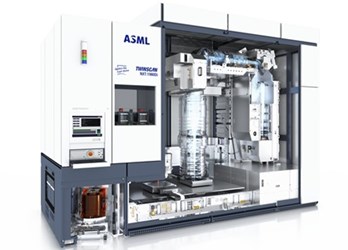ASML Ships New TWINSCAN NXT Immersion Lithography Platform
By Ed Biller

Demonstrated advancements in overlay and focus uniformity to address multiple patterning requirements at the most advanced logic and DRAM nodes
Veldhoven, the Netherlands – ASML Holding NV (ASML) today announced the first shipment of its new TWINSCAN NXT:1980Di immersion lithography system to support increasingly demanding multiple-patterning performance requirements. Demonstrating 1.2 nanometer (nm) dedicated chuck overlay and better than 10 nm focus uniformity, the NXT:1980Di features new grid calibrations and hardware that enables chipmakers to achieve tighter process windows for next-generation process nodes. The NXT:1980Di also improves throughput by 10% to 275 wafers per hour.
“Whether our customers face increased process complexity due to multiple patterning or plan to add Extreme Ultraviolet lithography, an improved level of immersion patterning is required in all leading-edge semiconductor manufacturing environments,” Bert Koek, Senior Vice President of DUV Product Marketing at ASML said. “The NXT:1980Di is a major leap forward in overlay, focus control and productivity, providing a cost-effective solution for chipmakers to further extend immersion lithography, and ultimately Moore’s Law.”
In future nodes, chipmakers are expected to use both immersion lithography and next-generation Extreme Ultraviolet (EUV) lithography, creating additional overlay requirements beyond the standard node-to-node improvements. The NXT:1980Di is specifically designed to accommodate the mix-and-match use with EUV, achieving about 2 nm matched-machine overlay.
The NXT:1980Di is currently available to customers. All TWINSCAN NXT:1970Ci systems can be upgraded in the field to the performance level of an NXT:1980Di. ASML also provides an upgrade path for previous TWINSCAN NXT models to further extend chipmakers’ capital investment. Additionally, as part of a rich portfolio of upgrade options, ASML offers add-on capabilities with the NXT:1980Di to address unique application needs, like a contrast enhancing alignment sensor to further improve overlay.
About ASML
ASML makes possible affordable microelectronics that improve the quality of life. ASML invents and develops advanced technology for high-tech lithography, metrology and software solutions for the semiconductor industry. ASML's guiding principle is continuing Moore's Law towards ever smaller, cheaper, more powerful and energy-efficient semiconductors. Our success is based on three pillars: technology leadership combined with customer and supplier intimacy, highly efficient processes and entrepreneurial people. We are a multinational company with over 70 locations in 16 countries, headquartered in Veldhoven, the Netherlands. We employ more than 14,000 people on payroll and flexible contracts (expressed in full time equivalents). Our company is an inspiring place where employees work, meet, learn and share. ASML is traded on Euronext Amsterdam and NASDAQ under the symbol ASML.
Forward Looking Statements
This document contains statements relating to certain projections and business trends that are forward-looking, including statements with respect to expected customer demand, expected trends, productivity of our tools and systems performance, expected development of our tools and systems, TWINSCAN and EUV system performance, and expected industry trends. You can generally identify these statements by the use of words like "may", "will", "could", "should", "project", "believe", "anticipate", "expect", "plan", "estimate", "forecast", "potential", "intend", "continue" and variations of these words or comparable words. These statements are not historical facts, but rather are based on current expectations, estimates, assumptions and projections about the business and our future financial results and readers should not place undue reliance on them. Forward-looking statements do not guarantee future performance and involve risks and uncertainties. These risks and uncertainties include, without limitation, economic conditions, product demand and semiconductor equipment industry capacity, worldwide demand and manufacturing capacity utilization for semiconductors (the principal product of our customer base), including the impact of general economic conditions on consumer confidence and demand for our customers' products, competitive products and pricing, the impact of manufacturing efficiencies and capacity constraints, performance of our systems, the continuing success of technology advances and the related pace of new product development and customer acceptance of new products, our ability to enforce patents and protect intellectual property rights, the risk of intellectual property litigation, availability of raw materials and critical manufacturing equipment, trade environment, changes in exchange rates, changes in tax rates, and other risks indicated in the risk factors included in ASML's Annual Report on Form 20-F and other filings with the US Securities and Exchange Commission. These forward-looking statements are made only as of the date of this document. We do not undertake to update or revise the forward-looking statements, whether as a result of new information, future events or otherwise.
Source: ASML
